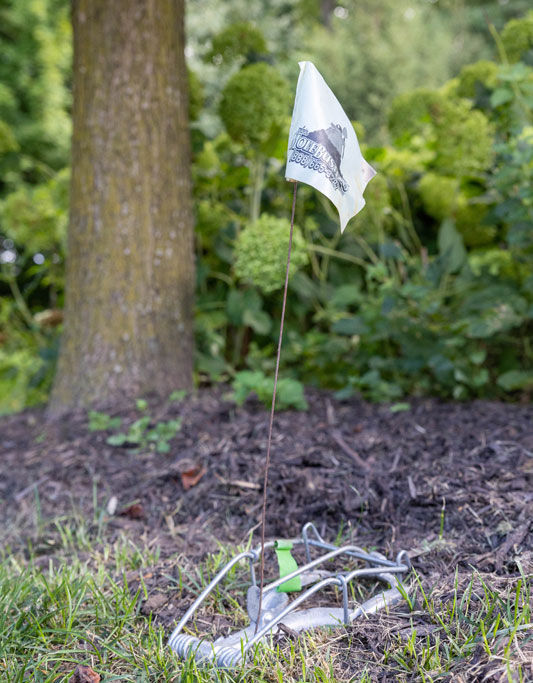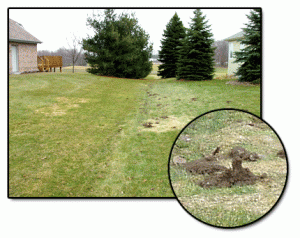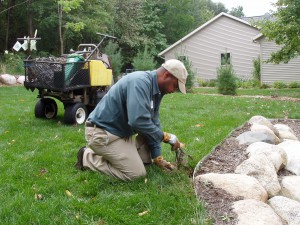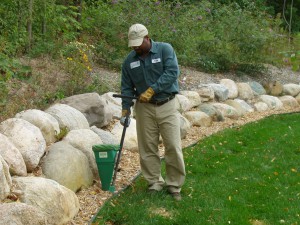Get Rid of Moles

Mole Facts:
- Moles do not hibernate. They are active every day of the year. The more snow on the ground, the thicker their blanket is to protect them from cold air.
- A mole can dig at the rate of 17 feet per hour.
- A mole’s speed through their mole tunnels can be 70 feet per minute, or just under one mile per hour.
- Moles will eat roughly half of their body weight in food each day.
- A mole eats an average of one earthworm every hour.
- Moles have twice as much blood as other mammals of similar size, allowing them to breath underground.
- Increased blood flow also allows for them to deal with the large increase in carbon dioxide found in their tunnels.
- Moles have to eat every three to four hours or they will starve to death.
- Moles are territorial and will defend their home.
- Moles are good swimmers. Flooding is a natural occurrence (especially in the spring when the snow melts) and moles have had millions of years to adapt to water in their tunnels.
What works and doesn’t to deter moles from tunneling in turf.
By Kevin Frank of Michigan State University published April 15, 2010.
I could not have said it better myself.
Highlights from mole season!
See our legendary Rodinator in action!
Many people believe every rumor or home remedy to control moles is worth trying. Moles are woodland animals in nature, but can quickly colonize and spread through adjacent residential properties. The longer moles are allowed to tunnel the more difficult they become to control. Mole activity will come and go throughout the season. New moles will move into existing deserted tunnels. Mole control is a continuous process that requires maintenance. There is no one time cure for moles. The mole’s primary source of food are worms so controlling the grubs in a lawn is not protection from mole activity.
Our 12 Step Mole Control Process:
1.) Email the client prior a couple of days advance so they know what day they are scheduled. The exception to this rule is the first visit. We get to all new clients ASAP. If we are scheduled to be in the neighborhood that same day or the next day we would not provide the advance email notification. The visits for our Mole Control program are scheduled every 10-14 days.
2.) Survey the property and surrounding areas for mole entry points.
3.) Distinguish between mole activity and other animal activity like voles.
4.) Distinguish between active and inactive mole tunnels.
5.) Distinguish between feeding tunnels and traveling tunnels.
6.) Measure depth and width of traveling tunnels to determine which trap works best.
7.) Evaluate the level of moisture in the soil to determine which trap will work the best.
8.) Set appropriate numbers of traps.
9.) Determine which bait to use based on location and depth of feeding tunnels.
10.) Determine if spraying the border of the property with a repellent would be of benefit, and spray as needed.
11.) Leave notes with the client about bait that was used, number of traps set or removed, and number of moles that were trapped.
12.) Monitor mole activity on an ongoing basis. As mole tunnels disappear, we keep replenishing the bait in the ground to stop the advancement of new moles.
| Tuff Turf Checklist | Tuff Turf Molebusters | Other Companies |
|---|---|---|
| Send an email & text notification before every service so you know who is coming, the technician’s name and picture, and what service they are providing. | ||
| Full-time technicians dedicated to mole control | ||
| The company runs a background check and performs random drug tests on the technicians that are on your property. | ||
| The technician is paid hourly, so he will do what is best for your lawn and not what gives him a commission or quota bonus. | ||
| Holds a DNR Wildlife Damage and Nuisance Control Permit. | ||
| Licensed with the Department of Agriculture for General Pests and Vertebrate Animals. | ||
| All companies have busy times of the day and a voice mail may have to be left. Your message is returned within an hour. | ||
| Accepts major credit cards, ACH Payments, and E-Checks. |

Our client is the lawn on the left
Some Experts “Claim” that Moles have no teeth. Here is a Michigan Mole with teeth:




In addition to servicing the homes of the founders of Amway and Steelcase, the following businesses have also used Tuff Turf’s mole control services:
Amber Ridge Condominiums
Bank One
Chandler Woods Charter School
Chilis Bar & Grille
Dan Vos Construction
Fifth Third Ball Park
Gun Lake Community Church
Hillside Community Church
Jade Pig Ventures
Kentwood Community Church
Mayflower Congregational Church
Millbrook Christian Reformed Church
Pinery Park Little League
Precision Property Management
Rio Grande Restaurant
Southern Little League
Stroo Funeral Home
York Creek Condominiums
American RV
Burger King Restaurant
Chase Bank
Cross Creek Charter School
Fazolis Restaurant
Grand Rapids Golf Club
Heritage Baptist Church
Huntington Woods Condominiums
Kelloggsville Public Schools
Legacy Christian School
McDonalds Restaurant
Plainfield Township
Railside Condominiums
South Christian High School
Spectrum Health
TriUnity Christian High School
York View Condominiums
Tuff Turf has also been hired or endorsed by the following landscape professionals:
Boverhof Landscape Services
Chuck’s Landscape Management
DK Lawn Care
Everett’s Landscape Management
HLS Lawn Care
Landscape Impressions
Meadowgreen, Inc.
Preferred Landscape Management
Ridgeview Landscaping
TS Groundskeeping
Wabeke Lawn Service
Weed Man
Bykerk Landscape Management
DJ’s Lawn Service
EarthScapes
Hilbrand’s Landscape Management
Intricate Lawn & Landscape
Larry’s Lawn Service
Oomkes Landscape Management
Premier Landscape
The Lawn Ranger
Vandenberg’s Landscape Maintenance
Weed & Feed Lawn Care


BURIED ITEMS
Please note that we are not responsible for damage to buried items. Buried items include, but are not limited to: invisible dog fences; underground sprinkling lines, valves, wires, and heads; utility lines; cable lines; landscape lighting; or drain tile. In order to set our traps, we cut slices in the ground that can be as deep as 6 inches. If you have an invisible dog fence it is recommended that you flag it since fences are usually only buried 1 to 2 inches down.


